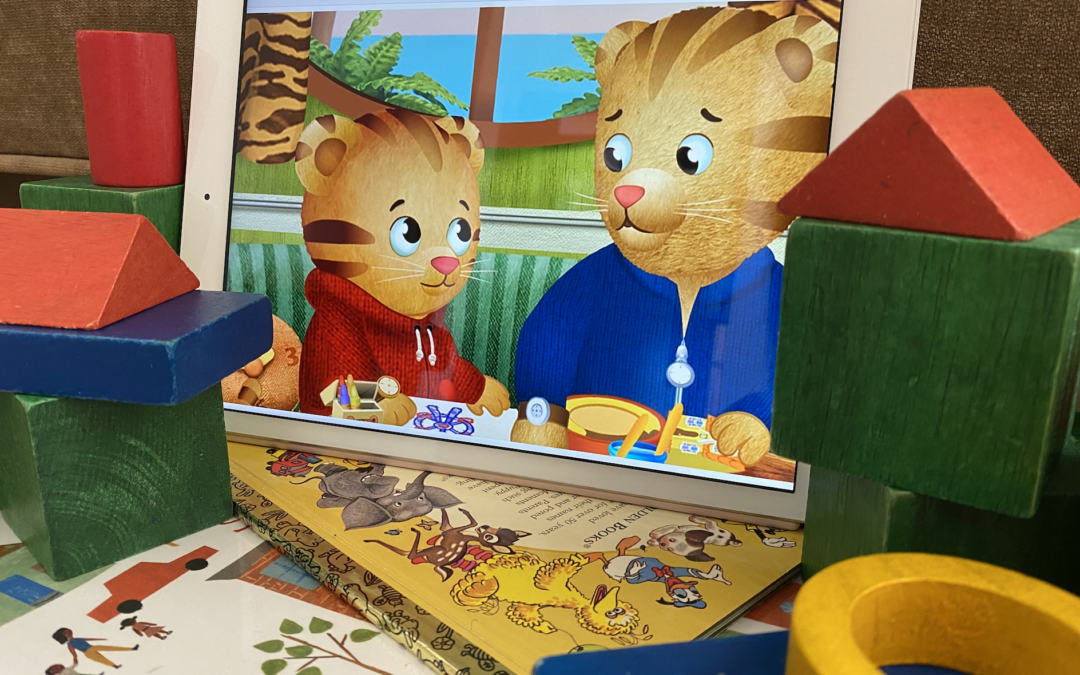The best remote learning experiences for preschoolers involve play and engagement with tangible materials on both sides of the screen.
An excerpt from my recent article in Early Insights.
The debate about children and screen time is a luxury we can no longer afford. Even the sternest critics of technology know that when your children are hungry, you feed them whatever food you have in your cupboard.
While there is no online equivalent to preschool, digital technologies can certainly enrich learning, especially when in-person play groups and preschools are not available. A recent survey conducted by the National Institute for Early Education Research (NIEER) showed that about 90% of preschool classrooms closed in March 2020. This huge reduction in preschool services affected all families, regardless of characteristics like race or ethnicity, parental education, and income. NIEER concludes that, “The results from our survey strongly suggest a generation of preschool children will face long-term negative consequences in their development because preschool systems failed to adequately respond to the pandemic.”
“We Do What We Do”
Given that access to in-person preschool this fall will also be limited, many children will continue to miss out on an important window of opportunity for early learning. Especially in households that lack developmentally appropriate learning materials such as picture books and blocks, and where adults may not be readily available to engage children in meaningful conversations and play, digital resources offer an important supplement to young children’s hands-on learning experiences. As preschool director Shannon Skeens recently commented on HELLO, the online discussion forum of the National Association for the Education of Young Children, “We do what we do. We think outside the box to keep those connections going and digital is part of that.”
Learning through Play
Play is essential to learning in early childhood. Play should always be at the center of learning for young children, whether the play is taking place in a digital environment or in a tangible environment. As Marina Bers of Kinderlabs has wisely noted, the best digital learning environments are playgrounds, not playpens. This means that digital tools for remote learning must be more than animated flashcards that teach letter names and counting. A digital playground for children is open-ended, sparking creativity and exploration. Well-designed digital games can also build social connections and community.
The best remote learning for preschoolers involve play and engagement with tangible materials on both sides of the screen. For example – When a preschool teacher leads a Zoom meeting with a preschool class, she can use puppets and props to engage children in stories and songs. The children can be invited to hold a toy and play along. Although the children in the class can’t physically engage with each other, everyone is able to touch, hold, and manipulate a physical object during the learning experience.
Preschoolers also need to move to learn. Remote learning experiences for young children must include movement, either as part of the screen-based learning experience or through frequent movement breaks. Digital learning can also be extended into physical play when children are invited to recreate a screen-based experience using hands-on craft materials and toys.
Quality Counts
Resources are available to guide parents and educators in selecting quality digital learning tools for young children. Common Sense Media provides ratings and recommendations for websites, apps and games. Britannica for Parents publishes resources and guidance for tech savvy families. And let’s not forget that public television is still one of the best sources for developmentally appropriate educational media.
Screen-based learning does not have to be interactive (via touchscreen, mouse, or keyboard) in order to engage young children. In fact, there’s growing evidence that “passive” screen experiences can result in better learning outcomes than interactive experiences. Decades of research has shown that educational television shows like Sesame Street help children learn early language, literacy, and math skills. The importance of educational television shows for young children is even greater now, due to the COVID-19 pandemic.
As Fred Rogers of Mister Roger’s Neighborhood once said, “In times of stress, the best thing we can do for each other is to listen with our ears and our hearts and to be assured that our questions are just as important as our answers.” Let’s continue to ask good questions about how we can best support early learning during these challenging times.
Sources
The Concept of Screen Time Is No Longer Relevant
There’s No Such Thing as Online Preschool
Remote Schooling Failed Our Preschoolers. We Have to Do Better.
Why Learning Through Play Is So Important
Think Playgrounds, Not Playpens
How to Use Games to Build Community
Why Young Kids Learn through Movement


Recent Comments